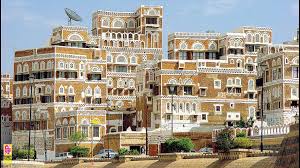
Sign in to your account




Sanaa
(Arabic: صَنْعَاء, Ṣanʿāʾ [sˤɑnʕaːʔ], Yemeni Arabic: [ˈsˤɑnʕɑ]; Old South Arabian: 𐩮𐩬𐩲𐩥 Ṣnʿw), also spelled Sanaʽa or Sana, is the largest city in Yemen and the centre of Sanaa Governorate. The city is not part of the Governorate, but forms the separate administrative district of "Amanat Al-Asemah". Under the Yemeni constitution, Sanaʽa is the capital of the country,[2] although the seat of the Yemeni government moved to Aden, the former capital of South Yemen in the aftermath of the Houthi occupation. Aden was declared as the temporary capital by President Abdrabbuh Mansur Hadi in March 2015.[3]
At an elevation of 2,300 metres (7,500 ft),[4] Sanaa is one of the highest capital cities in the world and is next to the Sarawat Mountains of Jabal An-Nabi Shu'ayb and Jabal Tiyal, considered to be the highest mountains in the country and amongst the highest in the region. Sanaa has a population of approximately 3,937,500 (2012), making it Yemen's largest city. As of 2020, the greater Sanaa urban area makes up about 10% of Yemen's total population.[5]
The Old City of Sanaa, a UNESCO World Heritage Site, has a distinctive architectural character, most notably expressed in its multi-storey buildings decorated with geometric patterns. In the conflict that raged in 2015, bombs hit UNESCO sites in the old city.[6][7] The Al Saleh Mosque, the largest in Sana'a, is located in the Old City.
Sanaa faces a severe water crisis, with water being drawn from its aquifer three times faster than it is replenished. The city is predicted to run completely out of water by around 2030, making it the first national capital in the world to do so. Access to drinking water is very limited in Sanaa, and there are problems with water quality.[8]
Sanaʽa features the very rare mild version of a desert climate (Köppen: BWk).[29] Sanaʽa sees on average 265 mm (10.43 in) of precipitation per year. Due to its high elevation, however, temperatures are much more moderate than many other cities on the Arabian Peninsula; average temperatures remain relatively constant throughout the year in Sanaʽa, with its coldest month being January and its warmest month July. Even considering this, as a result of its lower latitude and higher elevation, UV radiation from the sun is much stronger than in the hotter climates farther north on the Arab peninsula.
The city seldom experiences extreme heat or cold. Some areas around the city, however, can see temperatures fall to around −9 °C (16 °F) or −7 °C (19 °F) during winter. Frost usually occurs in the early winter mornings, and there is a slight wind chill in the city at elevated areas that causes the cold mornings to be bitter, including low humidity. The sun warms the city to the high 15–20 °C (59–68 °F) and low 21–26 °C (70–79 °F) during the noontime but it drops drastically as night falls in.
The city experiences many microclimates from district to district because of its location in the Sanaʽa basin and uneven elevations throughout the city. Summers are warm and can cool rapidly at night, especially after rainfall. Sanaʽa receives half of its annual rainfall during July and August. Rainfall amounts vary from year to year; some years could see 500–600 mm (20–24 inches) of rainfall, while others can barely get 150 mm (5.9 inches). High temperatures have increased slightly during the summer over the past few years, but low temperatures and winter temperatures have dramatically fallen over the same period.
Enter your Email to get latest news and other post in website